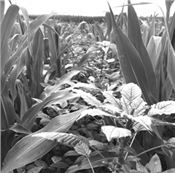Multi-Herbicide Resistant Palmer Amaranth Confirmed In Missouri
DR. MANDY D. BISH AND DR. KEVIN BRADLEY
COLUMBIA, MO.
In September, Southern Illinois University weed scientist Karla Gage along with Ronald Krausz, researcher and farm manager of SIU’s Belleville Research Center, identified a population of Palmer Amaranth with glyphosate – (group 9) and PPO- (group 14) resistance. This population, found just north of St. Louis in the Mississippi river bottoms, is the first confirmed case of multi-resistant Palmer amaranth in Missouri, and the first known instance of a Palmer amaranth population in Missouri with resistance to post-emergence applications of group 14 herbicides like fomesafen (Flexstar, Marvel, etc.), lactofen (Cobra), or aciflurofen (Ultra Blazer). The team sent tissue to the Illinois Plant Clinic where the samples were confirmed to have elevated copy numbers of the EPSPS gene, leading to glyphosate resistance, and the sample tested positive for a point mutation in the PPO gene known to confer resistance to PPO-inhibitor herbicides. PPO resistance in Palmer amaranth was first discovered in Tennessee in 2015 and more recently other populations have been discovered in southern Illinois. Midwest growers have had to contend with PPO-resistant populations of waterhemp for many years, and especially in Missouri and Illinois, multiple-resistant waterhemp is now the rule rather than the exception. This new finding with Palmer amaranth re-emphasizes the need for an integrated approach to the management of troublesome pigweed species like Palmer amaranth and waterhemp; one that includes multiple herbicide modes of action and cultural practices that minimize the deposition of weed seed back into the soil. If you have Palmer amaranth populations that you suspect are resistant to the group 14 herbicides, we'd like to hear about it and would be glad to discuss this with you further. ∆
DR. MANDY D. BISH AND DR. KEVIN BRADLEY: Division of Plant Sciences, University of Missouri

Palmer amaranth growing in a cornfield near West Alton, Missouri in 2016.
Photo courtesy of University of Missouri undergraduate Wyatt Coffman